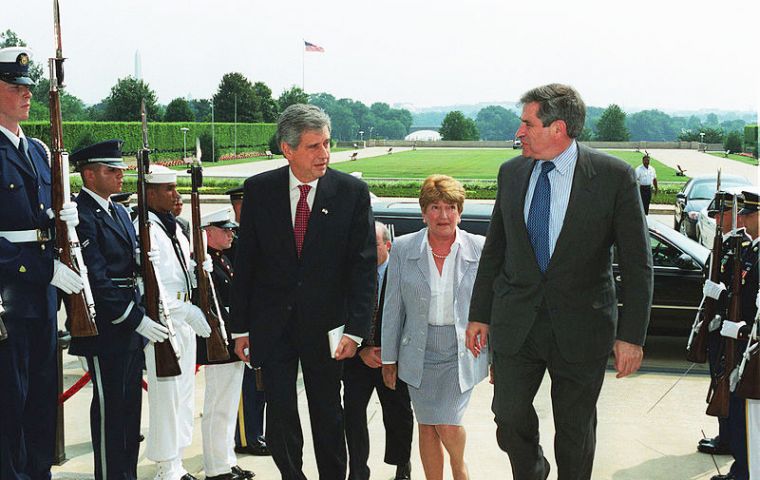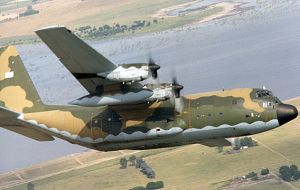MercoPress. South Atlantic News Agency
Argentina and US reestablish defense links after a nine-year freeze
 The delegation to Washington was headed by Angel Tello (L), head of Military Strategy and Affairs and Walter Ceballos, Defense Logistics Services
The delegation to Washington was headed by Angel Tello (L), head of Military Strategy and Affairs and Walter Ceballos, Defense Logistics Services  In the Pentagon the Argentine delegation held a round of talks with Rebecca Chavez, Deputy Assistant Secretary of Defense for Western Hemisphere Affairs.
In the Pentagon the Argentine delegation held a round of talks with Rebecca Chavez, Deputy Assistant Secretary of Defense for Western Hemisphere Affairs.  Apparently Argentina is interested in having access to Northrop F5 fighter jets and Mentor T-34 training aircraft
Apparently Argentina is interested in having access to Northrop F5 fighter jets and Mentor T-34 training aircraft  So far the upgrading of Argentina's ageing Hercules C 130 have benefitted from the US program of Foreign Military Sales
So far the upgrading of Argentina's ageing Hercules C 130 have benefitted from the US program of Foreign Military Sales Argentina and the United States are in the process of reestablishing strong defense links after a hiatus of seven years following this week's visit to the Pentagon of a high profile delegation from the ministry of defense which addressed several issues of mutual interest and common strategies.
The reborn friendly spirit is a result of the new Argentine government under president Mauricio Macri, which was blessed by a several-day visit to Argentina of president Barack Obama, last March, particularly since the new administration was only three months in office.
The delegation to Washington was headed by Angel Tello who has Deputy minister status as head of Military Strategy and Affairs, and Walter Ceballos, Defense Logistics Services and Emergencies Coordination secretary, while their host was, Rebecca Chávez, Deputy Assistant Secretary of Defense for Western Hemisphere Affairs.
“Our objective is to retake the political coordination that was normal between Argentina and the United States, and more specifically we're planning participation in peace missions, retaking courses for military staff and exchange of officers and coordinating actions in the event of catastrophe and emergency situations” explained Tello.
Likewise to strengthen bilateral defense relations ahead of the next Americas Defense ministers conference scheduled to take place in Trinidad Tobago in October.
“This is the first meeting of its kind since 2009, and catastrophe collaboration was one of the points addressed, particularly ”establishing a coordination mechanism for emergencies in the whole continent. The Ecuador earthquake comes to the point, many countries aided but independently, if this was a coordinated effort, results should have been better“, said Tello.
The Argentine delegation also revealed that the US pretends a more active contribution from Argentina in peace missions, and although the country is present in Haiti and Cyprus, ”we also talked about the possibility that Argentina sends a peace force to Colombia, once the final accord with the guerrillas is signed, under UN supervision. The military would be un armed, and acting as observers-inspectors“.
But as usually happens with this kind of meetings and official statements, what matters are the other issues addressed and not revealed. In effect, according to Argentine diplomatic sources the possibility of setting up a ”logistics base or station“ in Tierra del Fuego was in the agenda when the delegation left for Washington.
Most significant is Argentina's aspirations of having access to Northrop F5 fighter jets and Mentor T-34 training aircraft, in an attempt to replace de decommissioned Mirages, but this is highly conditioned by the current budget and financial situation faced by the Macri administration.”Brazil and Chile have F5s so it would reestablish a regional balance“.
The chances of considering a squadron of F/16s as was requested to US ambassador in Argentina Noah Namet in a letter dated 27 July 2015, seems to have been downgraded because this would only be possible with a generous ”financial flexibility” from the US.
However this has not impeded a fluid exchange, with the US State Department on defense issues. In effect last April, Rose Eilene Gottemoeller, Under Secretary of State for Arms Control and International Security for the U.S. State Department made an official visit to the Ministry of Defense in Buenos Aires. Furthermore the contacts with the Pentagon not only include the Ministry of Defense but also Fulvio Pompeo, head of Strategic Affairs and a strong candidate to take foreign secretary Susana Malcorra's post if she effectively is nominated as a candidate to replace UN Secretary General Ban Ki/moon.
Furthermore the US has already extended a hand when it comes to equipments for humanitarian aid, particularly transport aircraft. The upgrading of Argentina's ageing Hercules C 130 have benefitted from the US program of Foreign Military Sales, and a refurbished Hercules was officially presented earlier this month. In early April, US Air Force Secretary Deborah James also visited its Argentine peers in Buenos Aires.
Skimpy budgets and lack of financing have limited Argentina's capacity to recover loss of equipment and make the necessary minimum maintenance. Argentina has no near the power or fire capacity of the seventies and early eighties when it was involved in the South Atlantic conflict.




Top Comments
Disclaimer & comment rules-

-

-

Read all commentsThe Northrop F-5 FFS!
May 19th, 2016 - 07:31 am 0First flight 1959.
@1. One should not discount the F-5. It is still being operated, with modernised avionics and other improved systems, by the US Navy and Marine Corps. Although the two squadrons involved are adversary squadrons, i.e. for training purposes.
May 19th, 2016 - 07:59 am 0Used for years by the USAF aggressor squadrons.
May 19th, 2016 - 08:17 am 0Flown by them against Sea Harriers in about 1981.
IIR the kill ratio was in the order of 6 to 1 in favour of the Harrier.
Commenting for this story is now closed.
If you have a Facebook account, become a fan and comment on our Facebook Page!